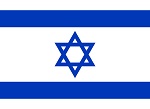Precision Model Art P0337 Israeli Magach 6B Medium Tank with Blazer Armor and KMT-4 Mine Roller - Mid East Wars (1:72 Scale)
"The one thing I cannot forgive the Arabs for is that they forced our sons to kill their sons."
- Israeli Prime Minister Golda Meir
 Magach (Hebrew: "battering-ram") is the designation of a series of tanks in Israeli service. The tanks are based on the American M48 and M60 Patton tanks. The name continued to be used for all Patton tanks, including the M60. Magach 1, 2, 3 and 5 are based on M48 series tanks where as Magach 6 and 7 are based on M60 series tanks.
Magach (Hebrew: "battering-ram") is the designation of a series of tanks in Israeli service. The tanks are based on the American M48 and M60 Patton tanks. The name continued to be used for all Patton tanks, including the M60. Magach 1, 2, 3 and 5 are based on M48 series tanks where as Magach 6 and 7 are based on M60 series tanks.
Prior to the 1982 invasion of Lebanon (1982 Lebanon War), Magach 6 and 7 tanks were fitted with explosive reactive armor (ERA). Further work has been done on the upgraded Magach 6 models, including new belly armor, Merkava tracks, new fire controls, a thermal sleeve for the gun and smoke grenades, eventually resulting in the Magach 6b (Bet) and ultimate 6b Gal Batash and equivalent Magach 7c Gimel models.
Since the 1980s and 1990s, the Magachs have been gradually replaced by Merkava tanks as Israel's front-line main battle tank. However, a large majority of the IDF's armored corps continued to consist of Magach variants until the 1990s, and the tank was continuously upgraded during this time.
By 2006, all Magachs in regular units had been replaced by Merkavas.
Pictured here is a 1:72 scale replica of an Israeli Defense Force Magach 6B medium tank with Blazer armor and an attached KMT-4 mine roller that was used in several Middle East conflicts. Sold Out!
Dimensions:
Length: 5-1/2-inches
Width: 2-inches
Release Date: April 2021
Historical Account: "Forty Years of Peace" - The 1982 Lebanon War, dubbed Operation Peace for Galilee (Hebrew: Mivtsa Shlom HaGalil or Mivtsa Sheleg) by the Israeli government, later known in Israel as the Lebanon War or the First Lebanon War (Milhemet Levanon Harishona), and known in Lebanon as "the invasion" (Arabic: Al-ijtiyaḥ), began on June 6th, 1982, when the Israel Defense Forces (IDF) invaded southern Lebanon, after repeated attacks and counter-attacks between the Palestine Liberation Organization (PLO) operating in southern Lebanon and the IDF that had caused civilian casualties on both sides of the border. The military operation was launched after gunmen from Abu Nidal's organization attempted to assassinate Shlomo Argov, Israel's ambassador to the United Kingdom. Israeli Prime Minister Menachem Begin blamed Abu Nidal's enemy, the PLO, for the incident, and used the incident as a casus belli for the invasion.
After attacking the PLO - as well as Syrian, leftist, and Muslim Lebanese forces - the Israeli military, in cooperation with their Maronite allies and the self-styled Free Lebanon State, occupied southern Lebanon, eventually surrounding the PLO and elements of the Syrian Army. Surrounded in West Beirut and subjected to heavy bombardment, the PLO forces and their allies negotiated passage from Lebanon with the aid of United States Special Envoy Philip Habib and the protection of international peacekeepers. The PLO, under the chairmanship of Yasser Arafat, had relocated its headquarters to Tripoli in June 1982. By expelling the PLO, removing Syrian influence over Lebanon, and installing a pro-Israeli Christian government led by President Bachir Gemayel, Israel hoped to sign a treaty which Menachem Begin promised would give Israel "forty years of peace".
Following the assassination of Gemayel in September 1982, Israel's position in Beirut became untenable and the signing of a peace treaty became increasingly unlikely. Outrage following the IDF's role in the Phalangist-perpetrated Sabra and Shatila massacre of Palestinians and Lebanese Shias, as well as Israeli popular disillusionment with the war, led to a gradual withdrawal from Beirut to the areas claimed by the Free Lebanon State in southern Lebanon (later to become the South Lebanon security belt), which was initiated following the May 17th Agreement and Syria's change of attitude towards the PLO.
After Israeli forces withdrew from most of Lebanon, the War of the Camps broke out between Lebanese factions, the remains of the PLO and Syria, in which Syria fought its former Palestinian allies. At the same time, Shi'a militant groups began consolidating and waging a low-intensity guerrilla war over the Israeli occupation of southern Lebanon, leading to 15 years of low-scale armed conflict. The Lebanese Civil War would continue until 1990, at which point Syria had established complete dominance over Lebanon.
Length: 5-1/2-inches
Width: 2-inches
|


